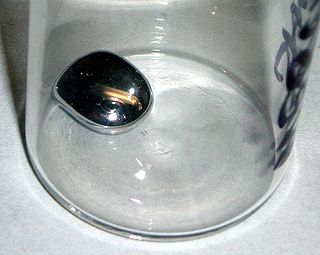Erethism
| Mercury poisoning, chronic (neurological symptomatology) | |
|---|---|

|
|
| Classification and external resources | |
| Specialty | Lua error in Module:Wikidata at line 446: attempt to index field 'wikibase' (a nil value). |
| ICD-10 | T56.1 |
| ICD-9-CM | 985.0 |
| DiseasesDB | 8057 |
| MedlinePlus | 002476 |
| eMedicine | emerg/813 |
| Patient UK | Erethism |
| MeSH | D020262 |
Erethism or erethism mercurialis is a neurological disorder which affects the whole central nervous system, as well as a symptom complex derived from mercury poisoning. This is also sometimes known as the mad hatter disease. Historically, this was common among old England felt-hatmakers who used mercury to stabilize the wool in a process called felting, where hair was cut from a pelt of an animal such as a rabbit. The industrial workers were exposed to the mercury vapors, giving rise to the expression “mad as a hatter.”[1] Some believe that the character the Mad Hatter in Lewis Carroll's Alice in Wonderland is an example of someone suffering from erethism, but the origin of this account is unclear. The character was almost certainly based on Theophilus Carter, an eccentric furniture dealer who was well known to Carroll.[2]
It is commonly characterized through behavioral changes such as irritability, low self-confidence, depression, apathy, shyness[3][4] and timidity, and in some extreme cases with prolonged exposure to mercury vapors, delirium, personality changes and memory loss occur as a result. People with erethism find it difficult to interact socially with others, with behaviors similar to that of a social phobia. Although most of the effects of erethism are neurological, some physical problems arise as well, including a decrease in physical strength, “headaches, general pain, and tremors after exposure to metallic mercury”[5] as well as irregular heartbeat. It has been documented that “the tremor in the hands can be so severe that the victim is unable to hold a glass of water without spilling its contents.”
The primary risk factor for erethism is long-term exposure to mercury vapors and gasses at high levels. One group at risk for mercury poisoning is industrial workers and those exposed to high levels of mercury residing naturally in the environment. Erethism is not as serious an issue as it was back before acceptable working condition regulations were enforced. Preventing mercury levels from getting too high limits the amount available for inhalation.
There is a risk of mercury poisoning in the home in some cases. Exposure to mercury vapor may stem from cultural and religious reasons where mercury is sprinkled on the floor of a home or car, burned in a candle, or mixed with perfume. Due to widespread use and popular concern, the risk of toxicity from dental amalgam has been exhaustively investigated. To date, no convincing evidence of toxicity has been found.[6][7]
One treatment of mercury poisoning was to admit fresh air to the patient by having him go outside daily as much as possible.[8] Stimulants such as ammonia have also been documented to help restore pulse to a normal rhythm. For a more comprehensive reading of treatment, see Mercury poisoning, 'Treatment' section.
Symptoms
Acute mercury exposure has given rise to psychotic reactions such as delirium, hallucinations, and suicidal tendency. Occupational exposure has resulted in erethism, with irritability, excitability, excessive shyness, and insomnia as the principal features of a broad-ranging functional disturbance. With continuing exposure, a fine tremor develops, initially involving the hands and later spreading to the eyelids, lips, and tongue, causing violent muscular spasms in the most severe cases. The tremor is reflected in the handwriting which has a characteristic appearance. In milder cases, erethism and tremor regress slowly over a period of years following removal from exposure. Decreased nerve conduction velocity in mercury-exposed workers has been demonstrated. Long-term, low-level exposure has been found to be associated with less pronounced symptoms of erethism, characterized by fatigue, irritability, loss of memory, vivid dreams, and depression (WHO, 1976).
Overview
Erethism is due to mercury poisoning. Mercury is an element that is found all over the earth in soil, rocks, and water. People who get erethism are usually exposed to jobs that have something to do with these elements, such as construction. People who work in factory jobs tend to have a higher chance of getting erethism. The problem with mercury is that if humans are exposed to any of the forms of mercury, depending on the amount (dose), route (ingestion, skin contact, inhalation), duration (time) of exposure, it can be toxic. Some elemental and chemical forms of mercury (vapor, methylmercury, inorganic mercury) are more toxic than other forms. The human fetus and medically compromised people (for example, patients with lung or kidney problems) are the most susceptible to the toxic effects of mercury.[9]
Medications
Some medications that can be used for erethism are Traid and Ritalin. Methylphenidate (Ritalin) is a stimulant drug approved for therapy of attention-deficit hyperactivity disorder, postural orthostatic tachycardia syndrome and narcolepsy. It may also be prescribed for off-label use in treatment-resistant cases of lethargy, depression (mood), or neural insult.
References
- ↑ Lua error in package.lua at line 80: module 'strict' not found.
- ↑ Lua error in package.lua at line 80: module 'strict' not found.
- ↑ WHO (1976) Environmental Health Criteria 1: Mercury, Geneva, World Health Organization, 131 pp.
- ↑ WHO. Inorganic mercury. Environmental Health Criteria 118. World Health Organization, Geneva, 1991.
- ↑ Lua error in package.lua at line 80: module 'strict' not found.
- ↑ Lua error in package.lua at line 80: module 'strict' not found.
- ↑ Lua error in package.lua at line 80: module 'strict' not found.
- ↑ Lua error in package.lua at line 80: module 'strict' not found.
- ↑ Medicine Health. "Mercury poisoning." Emedicine Health. N.p., 23 Apr. 2010. Web. 23 Apr. 2012. <http://www.emedicinehealth.com/mercury_poisoning/article_em.htm>.